I've been losing sleep over AI lately. Not because I'm worried about robots taking over the world—that's still science fiction and a worry to be had in another year.
But because every day I see another headline about ChatGPT writing code, DALL-E creating art, or some new AI tool that can do in minutes what used to take hours.
If you're like me, you've probably wondered: "Is my job next?"
It's a terrifying question, but here's what I've discovered after having a 3 hours chat with AI about history becayse we've been here before. Many times. And the people who thrived weren't the ones who fought the change—they were the ones who learned to dance with it.
Let me tell you some stories. Now to make it a little more interesting, these are fictional people but are real stories whose those whose jobs were "disrupted" by new technology. Some of these might sound familiar because the same fears, the same resistance, and ultimately the same opportunities are playing out right now with AI.
But here's the plot twist that most people miss: only one type of job (in the list below) has ever been completely eliminated by automation in the past 75 years. Just one. And the rest?
Well, that's where it gets interesting.
Let's go!
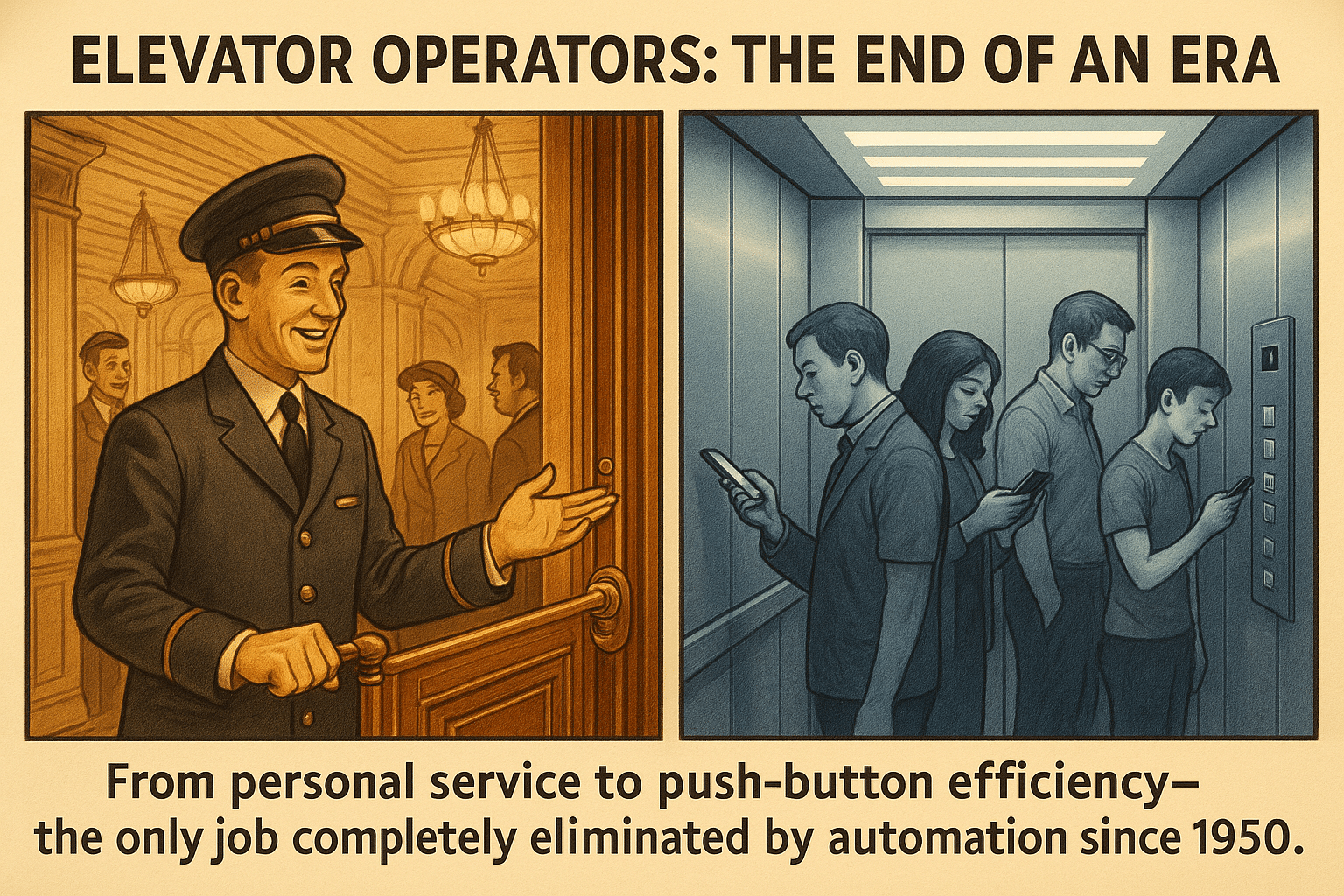
1. Elevator Operators: The Only Job Truly Lost to Automation
Let me start with the exception that proves the rule.
In a bustling 1950s New York skyscraper, James straightened his immaculate uniform, pride shining in his eyes. "Going up, Mrs. Henderson? How's little Tommy's piano recital preparation?" He knew every tenant's name, every child's birthday, every office gossip. His brass controls weren't just buttons—they were the keys to a vertical community.
Then came whispers of "automatic elevators." James laughed it off initially. "Who's going to remember that Mrs. Peterson needs to stop at 4 and 7? Who'll help Mr. Garcia with his heavy boxes?" But as weeks passed, he noticed fewer and fewer buildings hiring operators. The fear wasn't just about losing a job—it was about losing identity.
The Smart Ones Pivoted: James's colleague Robert saw the writing on the wall. He enrolled in night school to learn building maintenance and electrical systems. When the elevators went automatic, Robert became the building's chief maintenance supervisor, earning more than he ever did as an operator.
Here's what Harvard economist James Bessen discovered when he studied 270 occupations from the 1950 Census: elevator operator is the only job—the only job—completely eliminated by automation since 1950. That's not a typo. Out of hundreds of occupations, only one has vanished entirely.
At its peak, New York City alone had nearly 180,000 elevator operators. The Empire State Building employed 200 people just to run its elevators. Today? Zero. But here's what happened to the smart ones...
The impact:
- Directly Lost: All elevator operators (the sole completely automated profession)
- Indirectly Lost: Operator uniform manufacturers, elevator operation training schools, lobby concierge services
- Indirectly Created: Building automation technicians, elevator maintenance specialists, emergency response coordinators
- Ecosystem Shift: Lobbies transformed from warm, human-centered spaces to sterile, automated environments. The daily social fabric of office buildings unraveled, but buildings became more accessible and efficient.
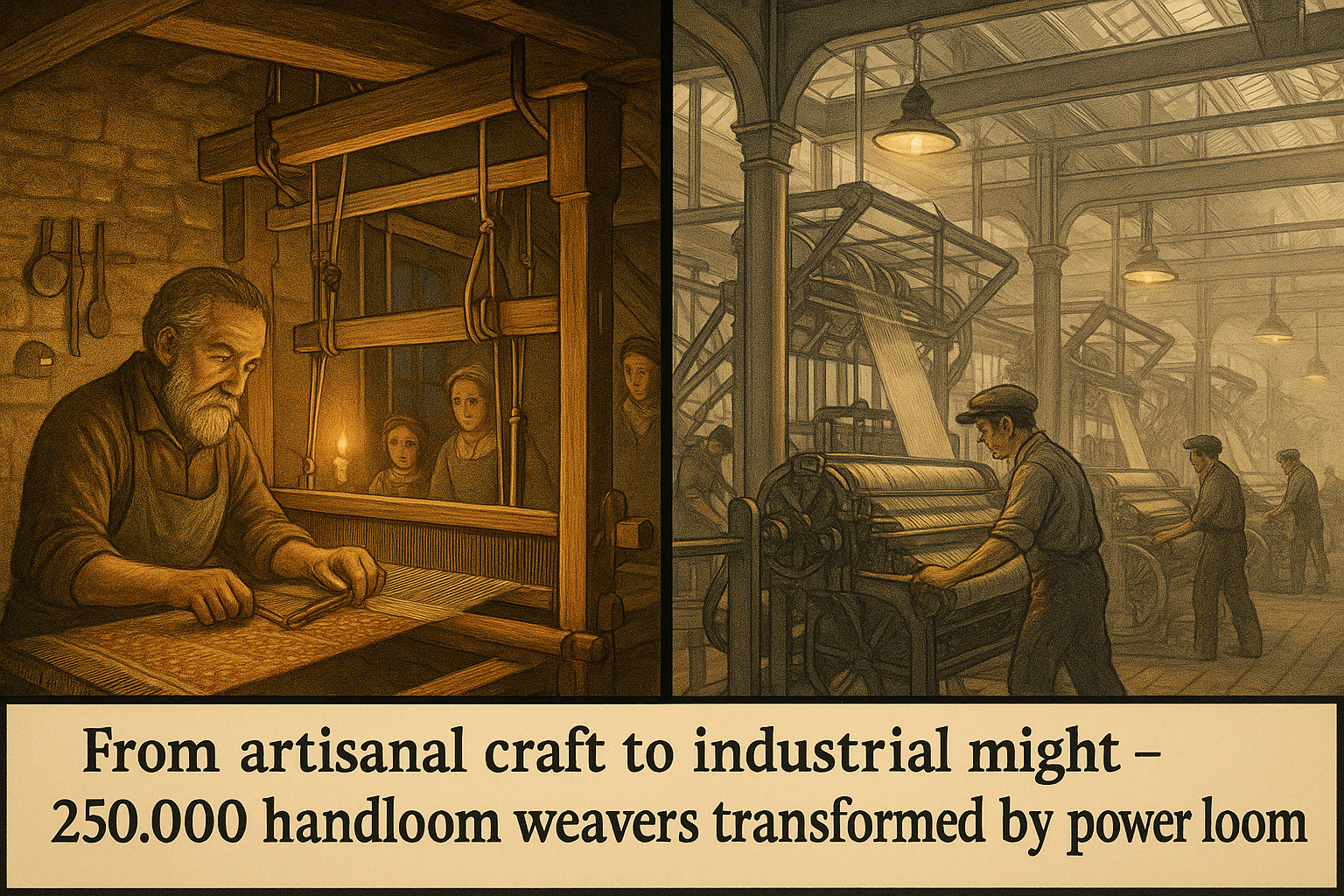
2. Handloom Weavers: The Original Disruption
Thomas was born into weaving. His father was a weaver, his grandfather too. In their candlelit cottage, Thomas worked the handloom with pride, each thread a deliberate choice, each pattern a small work of art. This wasn't just how he made money—it was who he was.
Then the mills came.
The power looms could weave faster than Thomas had ever imagined. Worse, they could work all night. Thomas watched his weekly wage collapse from 21 shillings in 1802 to barely 9 shillings by 1817. He couldn't feed his family.
I can't imagine that desperation. The craft that had sustained his family for generations was becoming worthless overnight. Some weavers, like Thomas, joined the Luddites—smashing the machines they blamed for their misery. But others saw a different path.
Thomas's brother William made a different choice. Instead of fighting the machines, he learned to work with them. He became a mill supervisor, earning steady wages and job security. Their neighbor's daughter, Elizabeth, used her deep understanding of textile patterns to become a designer for the new factories. She was essentially teaching machines to create beauty.
Around 1805, there were about 250,000 handloom weavers in the UK. By 1835, over 115,000 power looms were running in British factories. But here's the thing—the textile industry didn't shrink. It exploded. Cheaper cloth meant more people could afford it, and suddenly everyone wanted textiles. The industry employed more people than ever, just in different roles.
The impact:
- Directly Transformed: 250,000 handloom weavers (jobs evolved rather than disappeared)
- Indirectly Lost: Loom manufacturers, local wool merchants, village cottage industries
- Indirectly Created: Factory supervisors, textile machine operators, industrial designers, mill engineers
- Ecosystem Shift: Rural cottage industries collapsed, but industrial cities boomed. Traditional craftsmanship gave way to mass production, making textiles affordable for ordinary people.
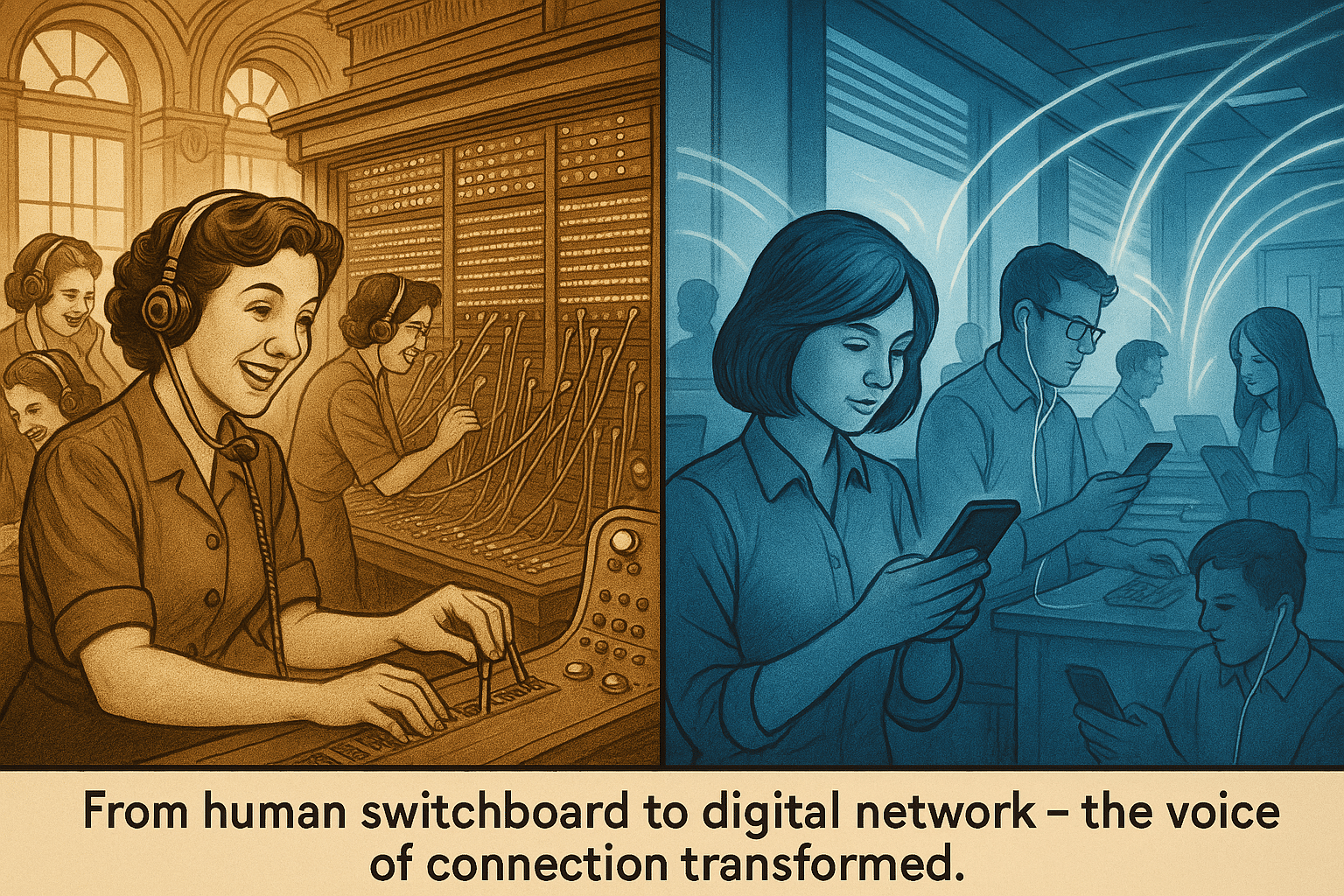
3. Telephone Switchboard Operators: Disconnecting Human Connection
"Number, please?" Margaret's voice was the first sound thousands heard each morning. From her bustling switchboard, she connected lovers, businesses, and emergency calls. She knew who was dating whom, which businesses were struggling, and when to prioritize the doctor's urgent calls.
The arrival of automatic switches felt like betrayal. Margaret had spent years perfecting her craft, memorizing numbers, learning to handle six calls simultaneously. Now a machine could do it all without coffee breaks or Christmas bonuses.
The Smart Ones Pivoted: Margaret's supervisor, Helen, anticipated the change and transitioned into telecommunications sales, leveraging her deep understanding of communication needs. She later founded a consulting firm helping businesses optimize their phone systems. Another operator, Joyce, used her customer service skills to become one of the first customer service representatives for a growing airline.
The Reality: At peak employment, hundreds of thousands of operators worked across the US. The transition to direct dial happened gradually from the 1950s through 1980s, allowing many operators to retire naturally or transition to other communication roles.
The impact:
- Directly Transformed: Hundreds of thousands of switchboard operators
- Indirectly Lost: Switchboard equipment manufacturers, operator training schools, local boarding houses
- Indirectly Created: Telecommunications engineers, customer service representatives, phone system installers
- Ecosystem Shift: Communication became faster but more impersonal. Communities lost their human information hubs, but long-distance calling became accessible to everyone.
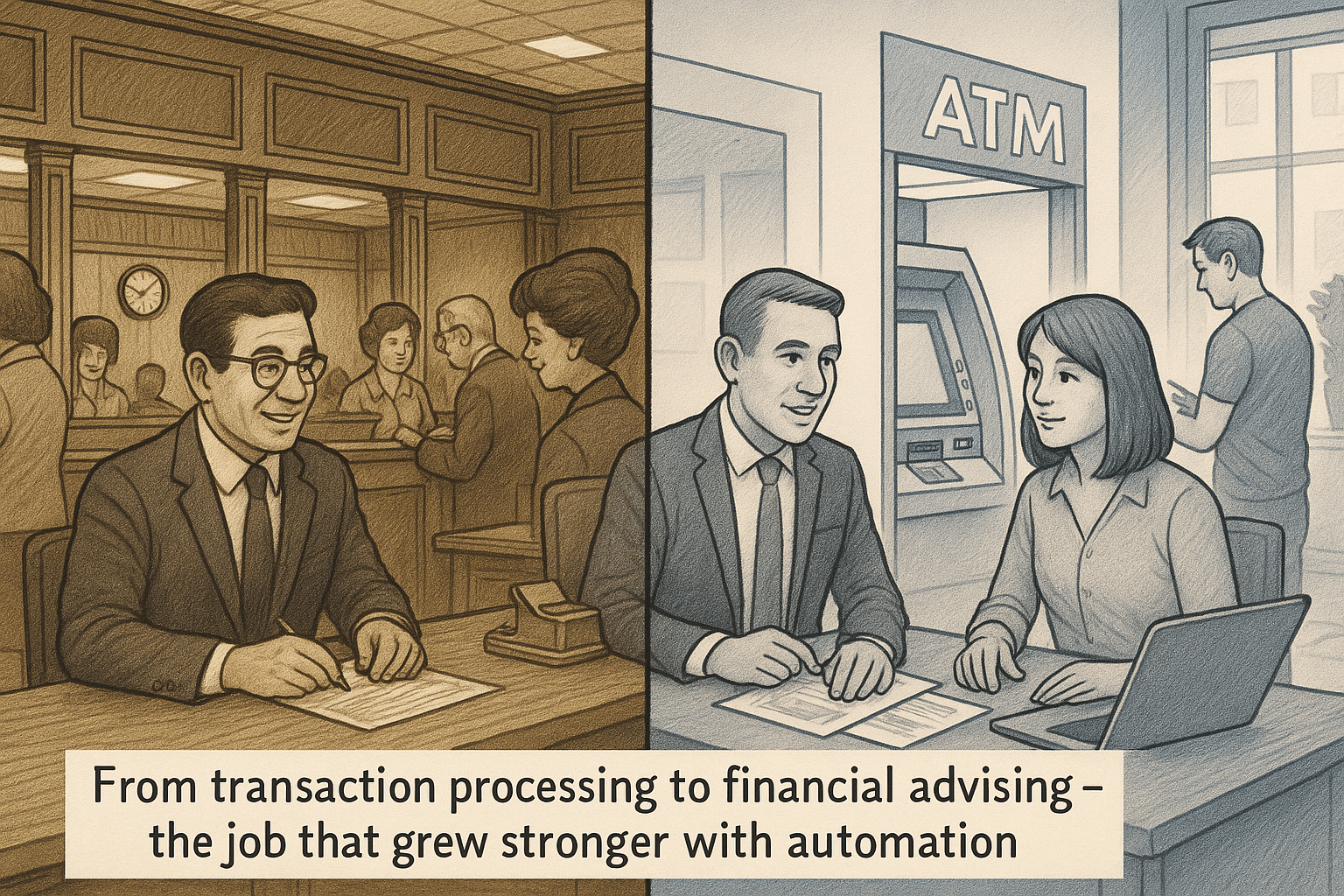
4. Bank Tellers: The Surprising Survivors
This story completely changed how I think about technology and jobs.
John had worked at First National Bank for fifteen years. He knew every customer's face, their kids' names, their financial dreams. When he counted out bills, his hands moved with practiced precision—cash drawer balanced to the penny, every evening, without fail.
Then, in the 1970s, the first ATMs arrived. The headlines were brutal: "Up to 75% of bank teller jobs will disappear." John watched his colleagues panic. Some started looking for new careers. Others talked about early retirement.
But something weird happened. Something nobody predicted.
The number of bank tellers actually increased.
I had to read this three times when I first learned it. From 1970 to 2000, teller employment grew faster than the overall job market. Today, we have nearly 500,000 ATMs in the US—and almost 500,000 bank tellers too.
Here's what happened: ATMs reduced the number of tellers needed per branch from about 21 to 13. But that made branches cheaper to operate. So banks opened more branches—a lot more. And more branches meant more tellers overall.
But the job changed. John wasn't just processing transactions anymore. He became a relationship manager, helping customers with loans, investments, and financial planning. The mundane stuff went to machines; the human stuff became more important.
The impact:
- Directly Transformed: Bank teller roles evolved rather than disappeared
- Indirectly Lost: Some traditional banking security roles, manual bookkeeping positions
- Indirectly Created: ATM technicians, branch managers, financial service specialists, "universal bankers"
- Ecosystem Shift: Banking became more accessible with longer hours and more locations. Tellers evolved from transaction processors to relationship managers and financial advisors.
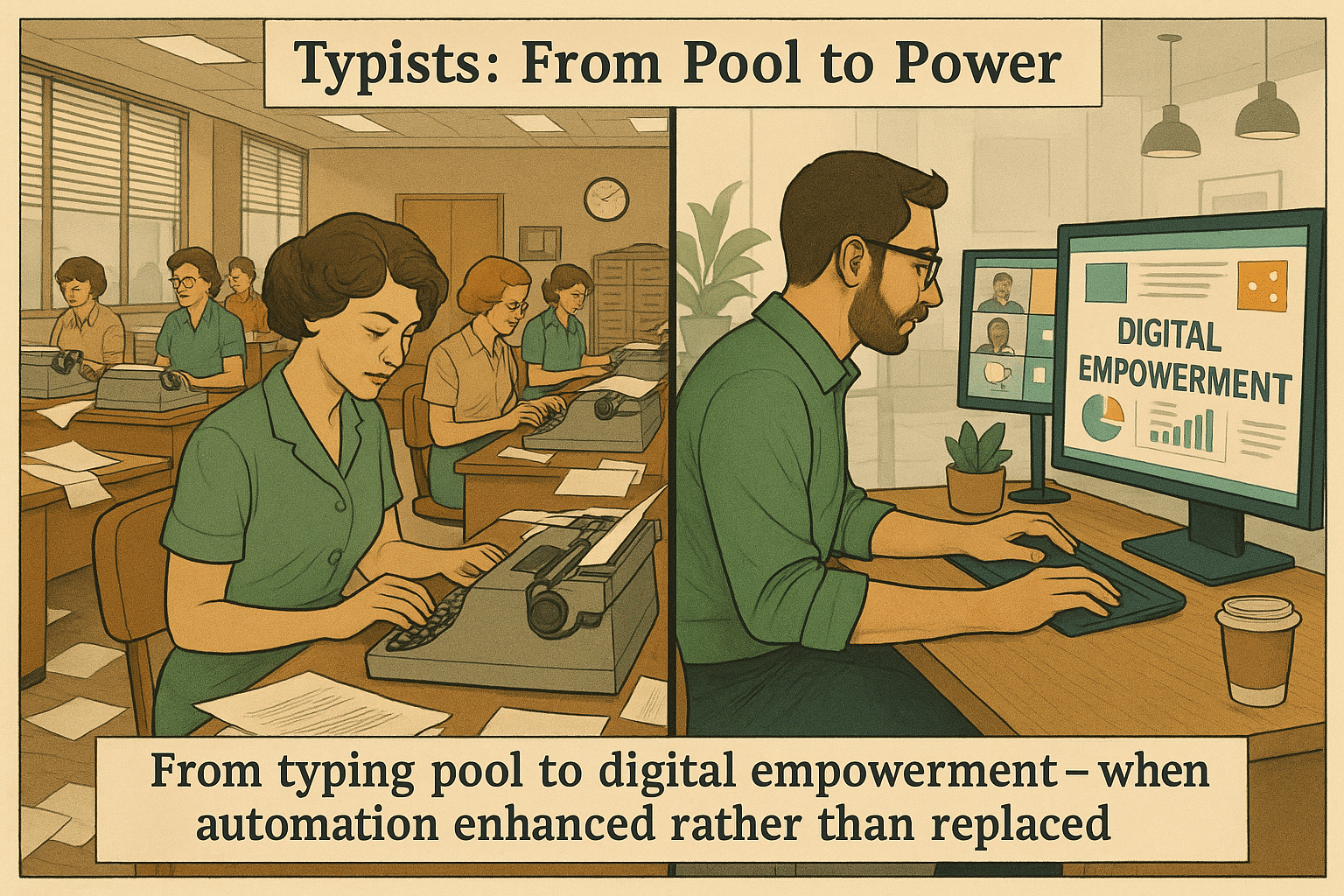
5. Typists & Stenographers: When Speed Became Obsolete
Linda's fingers flew across her typewriter at 120 words per minute, competing silently with colleagues in the office typing pool. The rhythmic clatter created its own music, and friendships bloomed over shared carbon paper and correction fluid disasters. She dreamed of becoming the executive secretary to the company president.
But one Monday morning, word processors arrived. "Don't worry," management said, "these will just make your work easier." Linda watched as the typing pool shrank, but noticed something interesting—the total number of secretarial and administrative jobs actually increased as word processing made document creation faster and more common.
The Smart Ones Pivoted: Linda's friend Patricia saw the shift coming and learned computer programming on weekends. She transitioned from typist to systems analyst, eventually becoming IT director. Another colleague, Maria, leveraged her organizational skills to become a project manager, finding that her typing speed translated beautifully to rapid digital communication.
The Reality: While traditional typing pools disappeared, the overall administrative and clerical workforce grew. Word processing technology made document creation so much faster that demand for written communication exploded, creating new types of jobs.
The impact:
- Directly Transformed: Traditional typing pools eliminated, but secretarial work evolved
- Indirectly Lost: Typewriter manufacturers, carbon paper suppliers, typing schools
- Indirectly Created: Computer training centers, software support specialists, administrative assistants with expanded roles
- Ecosystem Shift: Office productivity soared. The entry-level professional pipeline changed but expanded, opening new technical career paths.
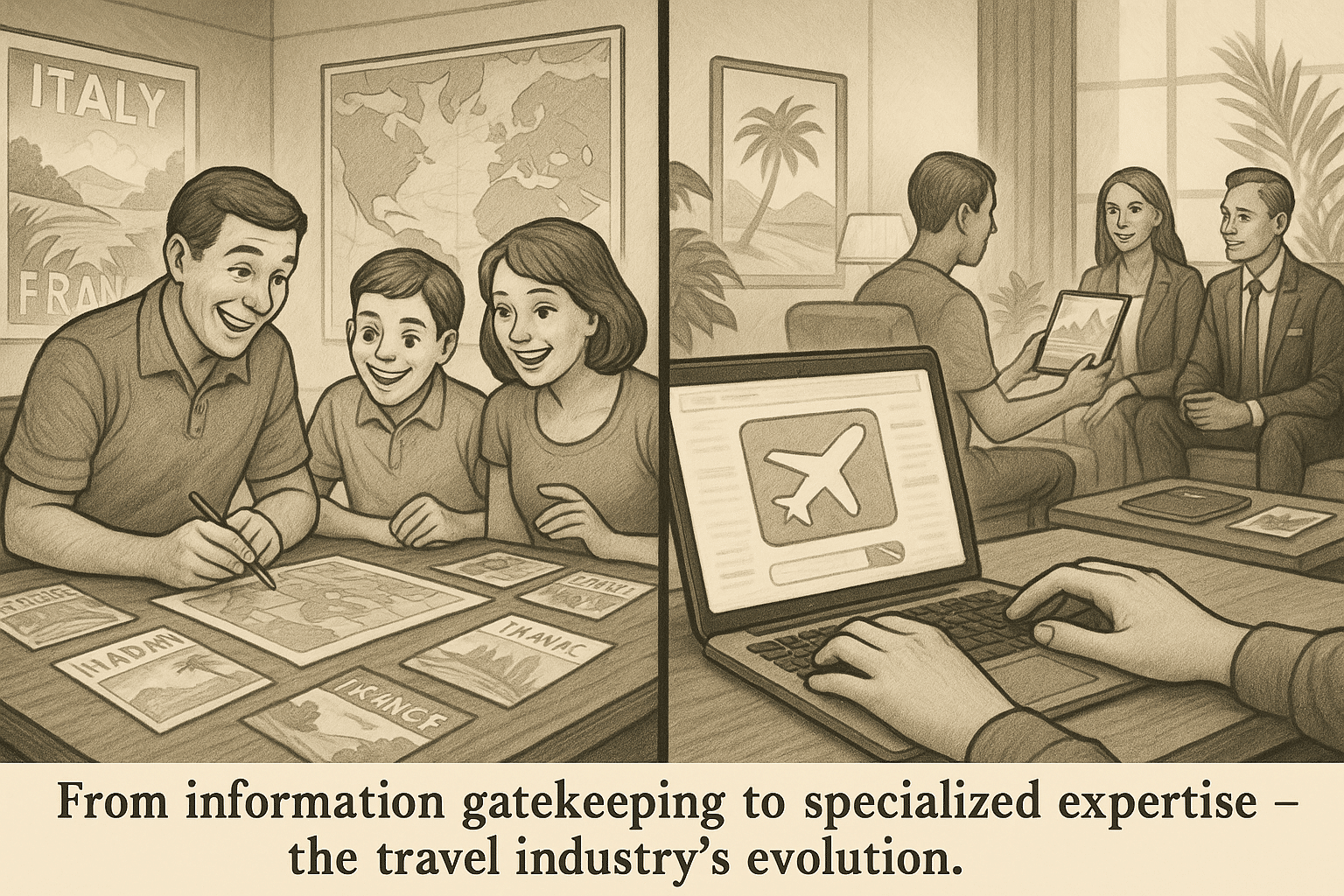
6. Travel Agents: Gatekeepers of Dreams
Sarah expertly designed dream vacations, each itinerary a masterpiece of timing, comfort, and discovery. She knew which hotels had the best views, which restaurants to avoid, and how to navigate visa requirements. Her clients trusted her implicitly with their most precious commodity: vacation time.
Online booking platforms appeared innocently at first—"just for simple flights." But as these platforms became more sophisticated, many traditional travel agents found their services commoditized.
The Smart Ones Pivoted: Sarah's colleague David specialized in luxury and adventure travel, niches that required human expertise. He built a boutique agency focusing on ultra-high-end experiences that couldn't be easily booked online. Another agent, Nancy, became a corporate travel manager, handling complex business travel needs that required human judgment and relationship management.
The Reality: While many traditional travel agents closed, the industry transformed rather than disappeared. Specialized travel advisors, corporate travel managers, and luxury travel consultants found new niches. The total number of travel-related jobs actually increased as travel became more accessible.
The impact:
- Directly Transformed: Traditional travel agents evolved into specialized consultants
- Indirectly Lost: Travel brochure printers, traditional travel insurance brokers
- Indirectly Created: Online travel platform developers, travel bloggers, specialized tour operators, destination experience designers, and you can argue AirBnb.
- Ecosystem Shift: Travel became more accessible and affordable for ordinary people. DIY travel culture emerged, but specialized expertise became more valuable for complex trips.
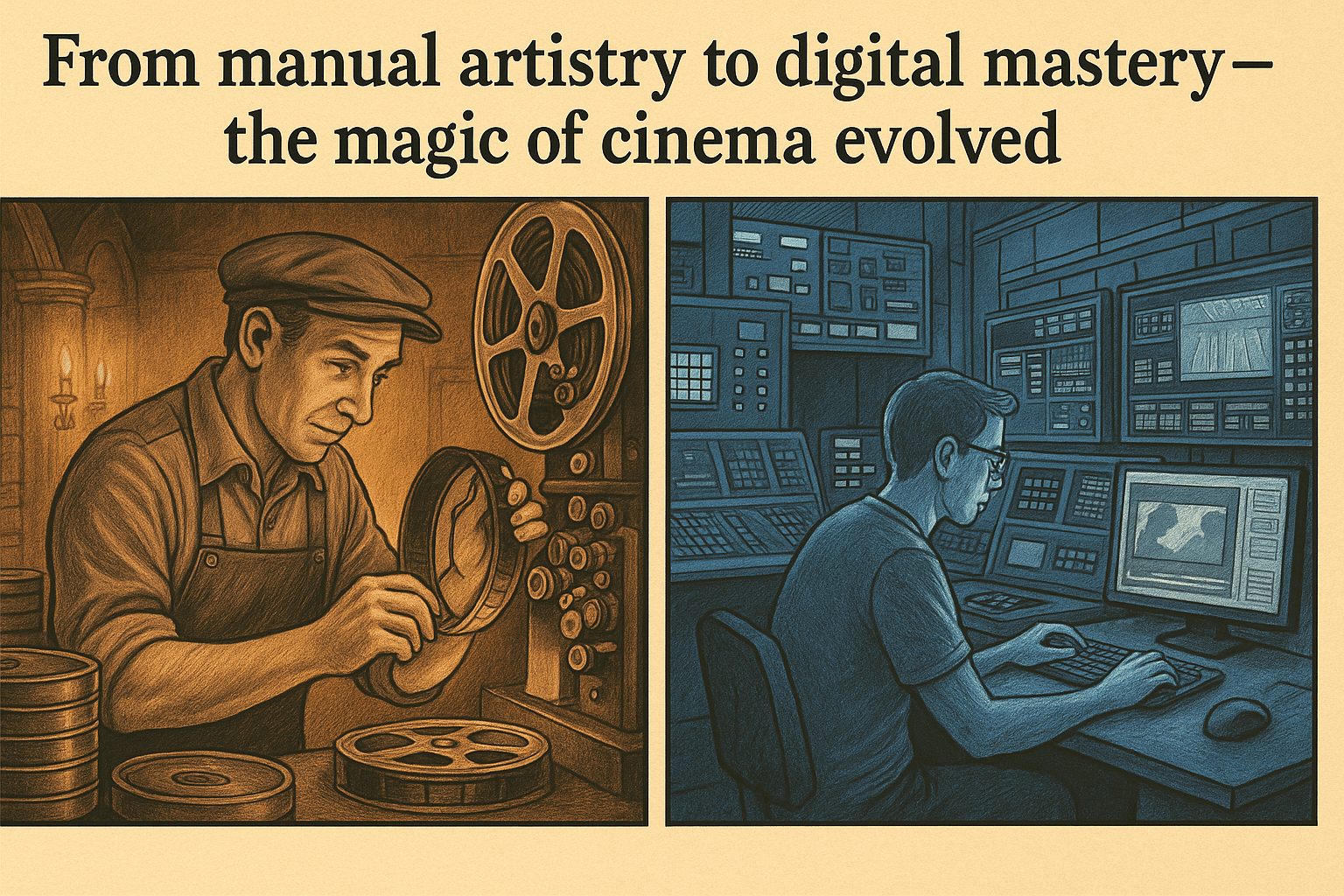
7. Film Projectionists: Masters of the Silver Screen
Carlos threaded film reels with practiced hands, orchestrating cinema magic. He knew exactly when to change reels, how to adjust focus for optimal viewing, and how to fix mechanical problems mid-screening. His booth was his kingdom, and he took pride in delivering perfect movie experiences.
Digital projectors appeared—automated and nearly foolproof. Carlos watched as his skilled craft was reduced to pressing "play." But the movie industry was expanding rapidly, creating new opportunities.
The Smart Ones Pivoted: Carlos's friend Miguel learned digital projection systems and became a cinema technical manager, overseeing multiple theaters' automated systems. Another projectionist, Tony, used his understanding of visual storytelling to become a film editor, transitioning from exhibiting movies to creating them.
The Reality: While traditional film projection became automated, the growth of multiplex cinemas and the expansion of the entertainment industry created new technical roles. The skills transferred to digital media production, home theater installation, and cinema management.
The impact:
- Directly Transformed: Film projectionists became cinema technical specialists
- Indirectly Lost: Film reel manufacturers, traditional projection equipment suppliers
- Indirectly Created: Digital cinema technicians, home theater installers, media server specialists
- Ecosystem Shift: Cinema operations became more reliable and efficient. The barrier to entry for filmmakers decreased, democratizing movie production.
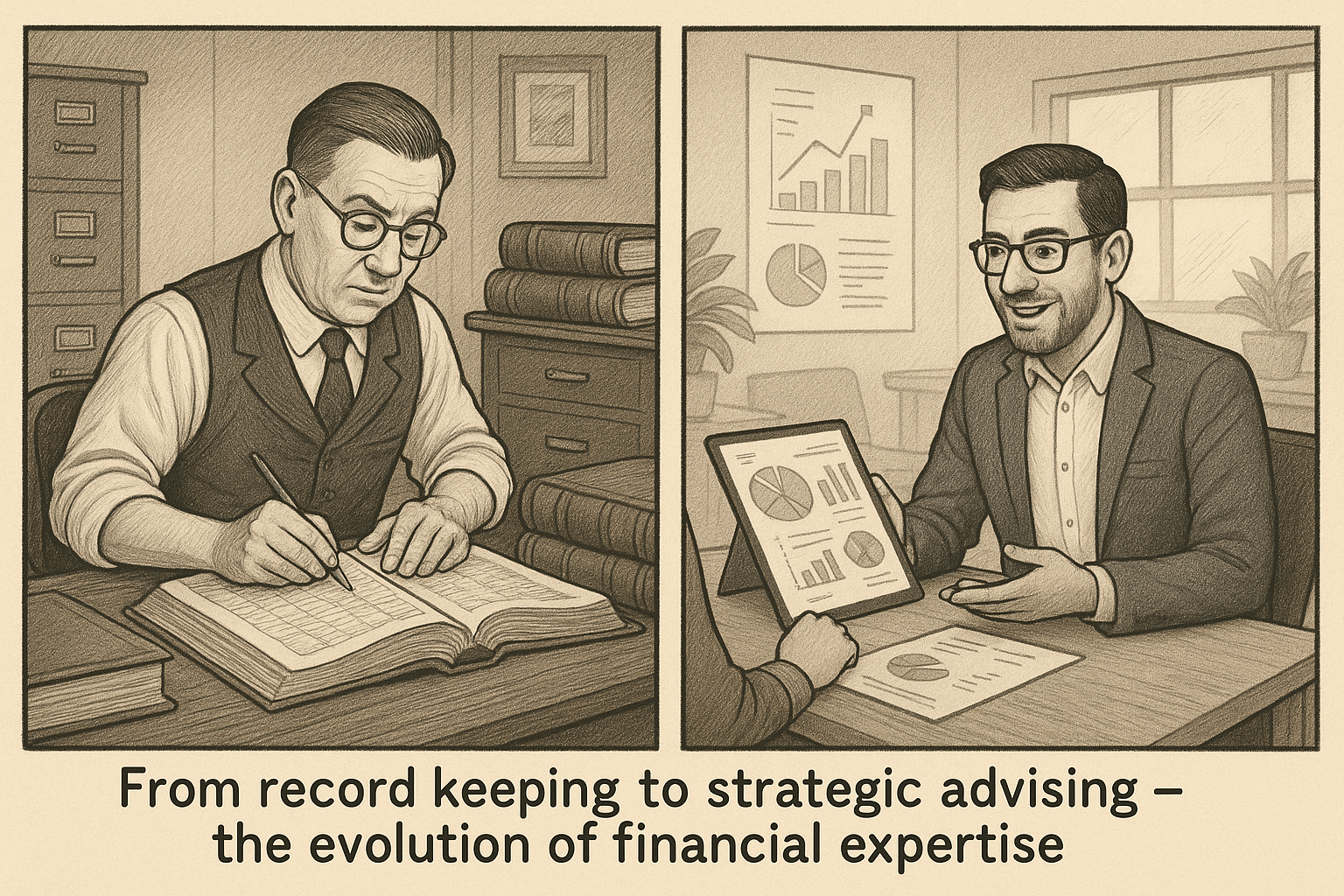
8. Bookkeepers: The Guardians of Financial Truth
Michael meticulously recorded transactions by hand, the cornerstone of business accuracy. His ledgers were works of art—neat columns, perfect arithmetic, and a complete financial story of every business he served. He was trusted with companies' most sensitive information.
When spreadsheets arrived, training sessions felt humiliating. Decades of knowledge seemed condensed into simple keystrokes. But Michael discovered something unexpected—automation handled routine tasks, freeing him for higher-value analysis.
The Smart Ones Pivoted: Michael's colleague Rachel embraced the new technology and became a certified public accountant, using software to handle routine tasks while focusing on financial analysis and advisory services. Another bookkeeper, Paul, transitioned into business consulting, helping small businesses understand and use their financial data strategically.
The Reality: While manual bookkeeping disappeared, the demand for financial analysis, tax preparation, and business advisory services grew dramatically. Automation made financial services more accessible to small businesses, expanding the market.
The impact:
- Directly Transformed: Manual bookkeepers became financial advisors and analysts
- Indirectly Lost: Ledger book manufacturers, manual accounting supplies
- Indirectly Created: Financial software trainers, business consultants, tax preparation specialists
- Ecosystem Shift: Financial record-keeping became more accurate and accessible. Small businesses gained access to sophisticated financial analysis previously available only to large corporations.
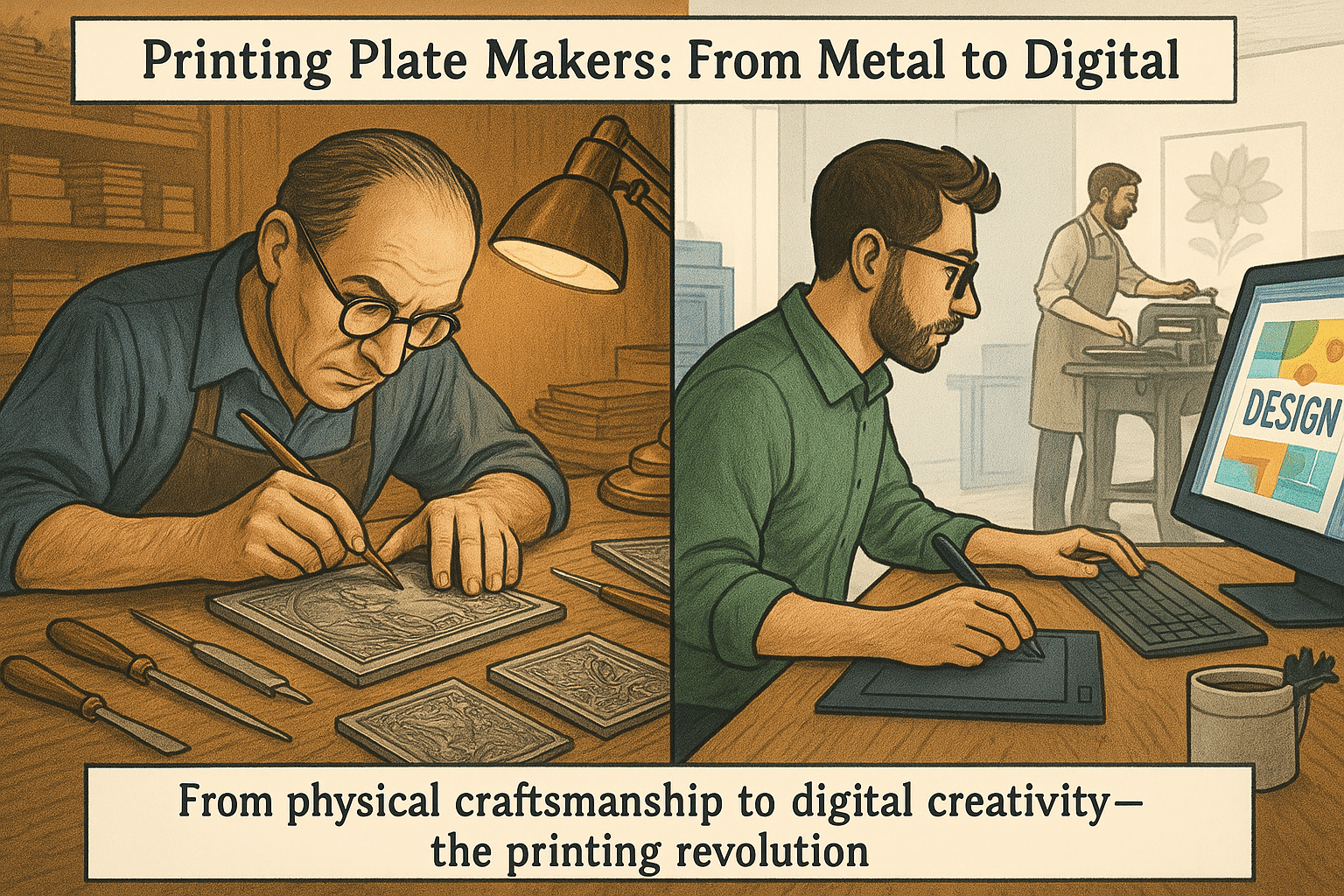
9. Printing Plate Makers: Artists of the Press
The craftsmanship in Aaron's plate-making defined print quality. Each plate was hand-engraved, a perfect balance of art and precision. Aaron's work appeared in newspapers, magazines, and advertisements across the country. He was a skilled artisan in an industry that valued perfection.
Digital printing revolutionized the industry, but it also democratized publishing and created new opportunities for visual creativity.
The Smart Ones Pivoted: Aaron's apprentice, Kevin, learned digital prepress technology and became a graphic designer, translating his understanding of print quality into digital media. Another plate maker, George, started a specialty printing business focusing on high-end, artisanal products that still required hand-crafted elements.
The Reality: While traditional plate-making disappeared, the printing and design industries expanded dramatically. Digital printing made small-run printing economical, creating opportunities for independent publishers, designers, and artists.
The impact:
- Directly Transformed: Plate makers became graphic designers and print specialists
- Indirectly Lost: Traditional engraving tool manufacturers, plate storage facilities
- Indirectly Created: Digital prepress technicians, graphic designers, small-run printing businesses
- Ecosystem Shift: Print production became faster, cheaper, and more accessible. Independent publishing flourished, and visual design became a growth industry.
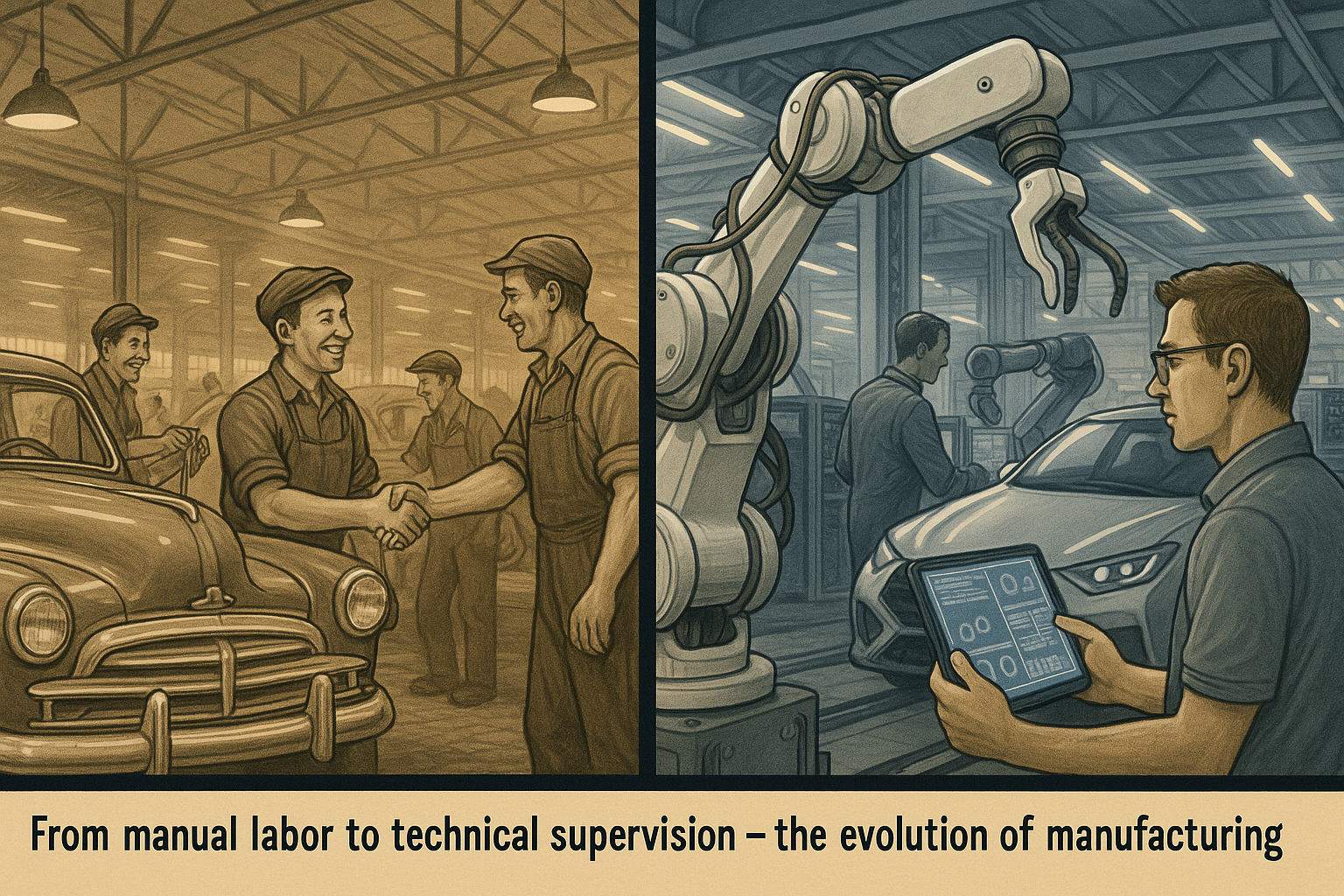
10. Assembly Line Workers: The Heartbeat of Industry
Detroit factories hummed with life, providing workers like Joe camaraderie and steady income. The assembly line was more than work—it was community, purpose, and the pride of building America's automobiles. Joe knew every bolt, every process, every colleague's story.
Robotics transformed manufacturing, but the automotive industry was also expanding globally and developing new technologies that required different types of skilled workers.
The Smart Ones Pivoted: Joe's friend Danny learned robotics maintenance and became a technician, earning more than he ever did on the line. Another worker, Lisa, leveraged her quality control experience to become a manufacturing engineer, designing the systems that improved production quality and efficiency.
The Reality: While traditional assembly line jobs declined in some sectors, manufacturing employment transformed rather than disappeared. Advanced manufacturing, robotics maintenance, and quality control created new skilled positions. Many manufacturing jobs moved to other regions and countries, but high-skilled manufacturing jobs increased in developed countries.
The impact:
- Directly Transformed: Assembly line workers became manufacturing technicians and quality specialists
- Indirectly Lost: Traditional factory support services, some local manufacturing communities
- Indirectly Created: Robotics technicians, manufacturing engineers, quality control specialists, automation programmers
- Ecosystem Shift: Manufacturing became more efficient and higher-skilled. While some factory towns struggled, others reinvented themselves as high-tech manufacturing centers.
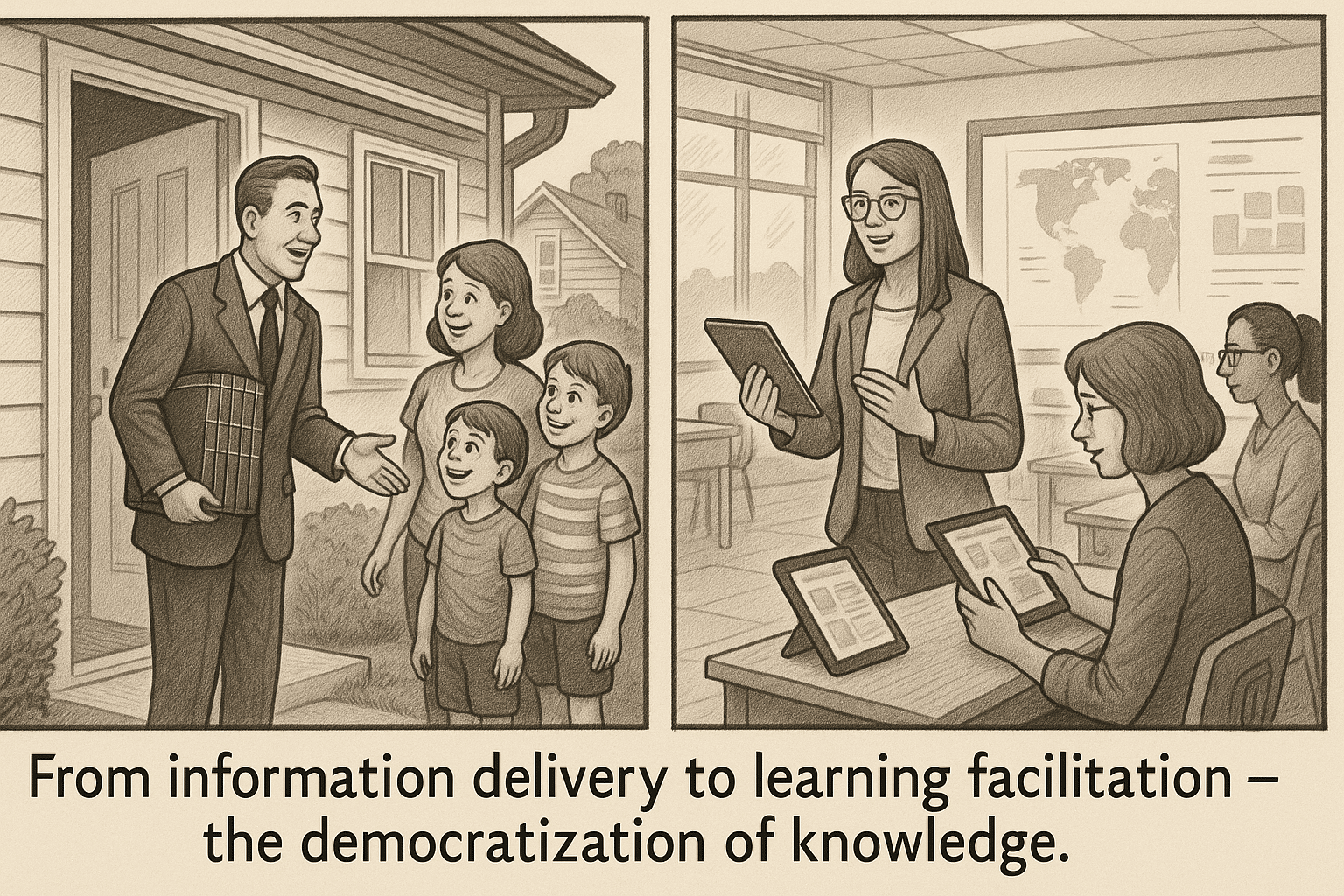
11. Encyclopedia Salespeople: Dealers in Knowledge
Laura passionately sold encyclopedias door-to-door, providing families access to the world's knowledge. She believed deeply in education's power and took pride in bringing learning into homes. Her sales were relationships built on trust and shared values about children's futures.
The internet democratized access to information, but it also created new opportunities in education technology and online learning.
The Smart Ones Pivoted: Laura's colleague Michael transitioned into educational technology sales, helping schools implement computer systems and online learning platforms. Another salesperson, Jennifer, became a corporate trainer, using her presentation skills and understanding of learning to help companies educate their employees.
The Reality: While door-to-door encyclopedia sales disappeared, the education and information industries exploded. Online education, corporate training, and educational technology became major growth sectors.
The impact:
- Directly Transformed: Encyclopedia salespeople became educational technology specialists
- Indirectly Lost: Encyclopedia printing, door-to-door sales training companies
- Indirectly Created: Educational technology specialists, online content creators, corporate trainers, e-learning developers
- Ecosystem Shift: Knowledge access became democratized and immediate. The education industry transformed from information delivery to learning facilitation and skill development.
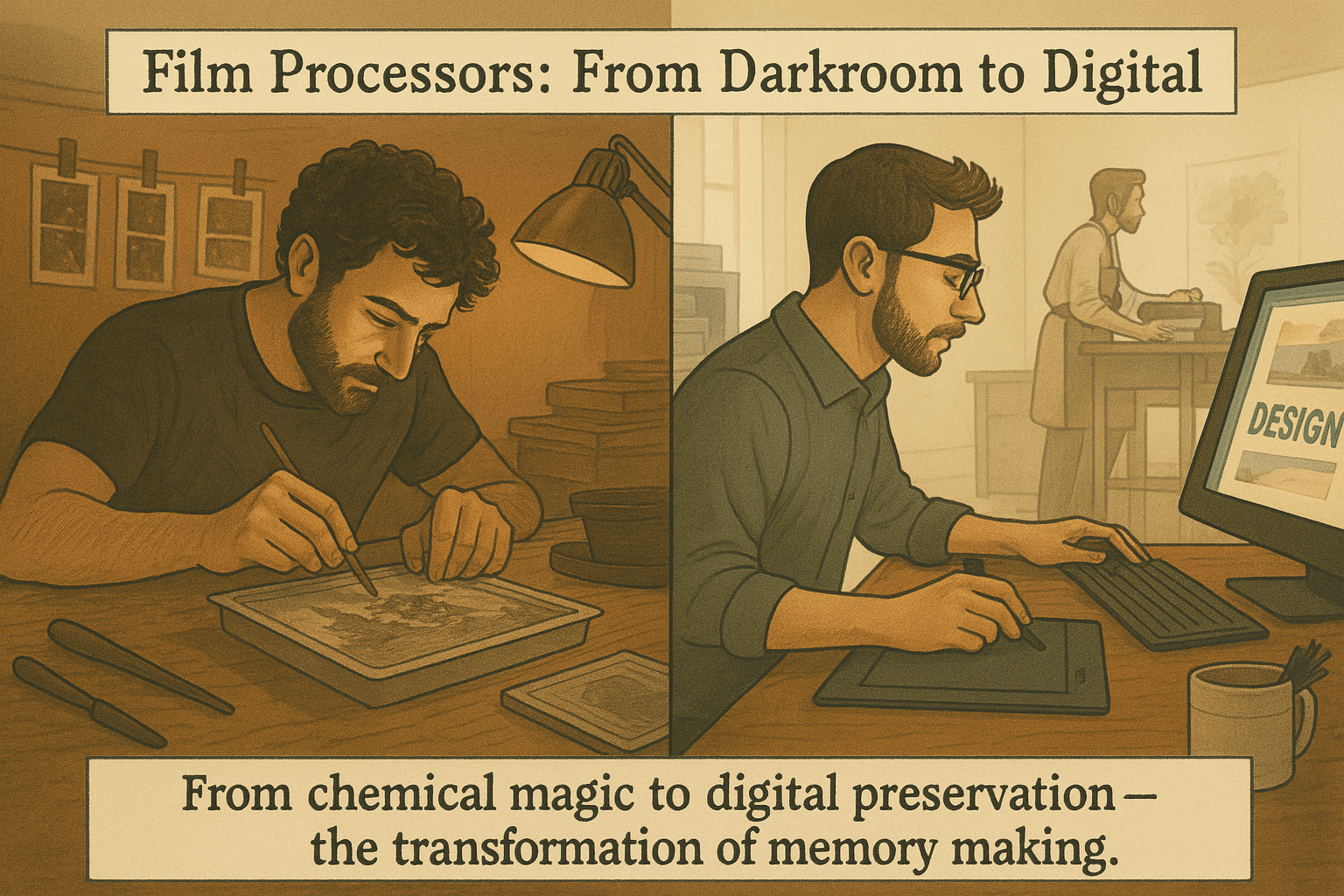
12. Film Processors: Developers of Memory
In bustling photo labs, Emily lovingly developed memories captured on film. She understood chemistry, timing, and the art of bringing moments to life. Her lab was where birthdays, graduations, and family vacations became tangible memories.
Digital photography eliminated film processing, but it also made photography more accessible and created new opportunities in digital media and memory preservation.
The Smart Ones Pivoted: Emily's assistant, Carlos, learned digital photography and became a wedding photographer, using his understanding of image quality to excel in the new medium. Another processor, Maria, transitioned into photo restoration and digitization, helping families preserve and organize their existing photo collections.
The Reality: While film processing disappeared, the photography industry expanded dramatically. Digital photography made everyone a photographer, creating new markets for photo services, digital storage, and memory preservation.
The impact:
- Directly Transformed: Film processors became digital photography specialists
- Indirectly Lost: Film manufacturers, photo paper suppliers, traditional photo equipment
- Indirectly Created: Digital photography specialists, photo restoration experts, cloud storage providers, social media platforms
- Ecosystem Shift: Photography became instant, ubiquitous, and shareable. The volume of photos created exploded, creating new industries around photo management, sharing, and preservation.
The AI Revolution: What History Really Tells Us
After studying these stories, I realized something important: we've been asking the wrong question about AI.
The question isn't "Will AI take my job?" It's "How will AI transform my job, and how can I transform with it?"
Look at the pattern. The elevator operator is the exception—the only job completely eliminated by automation in 75 years. Everything else evolved. Sometimes painfully, sometimes surprisingly, but almost always with new opportunities for those who adapted.
I'll be honest—this doesn't make the transition any less scary. Change is hard. Learning new skills while juggling current responsibilities is exhausting. But history shows us that the people who lean into change, rather than resist it, don't just survive—they thrive.
Think about it: if you're a graphic designer, AI image generators aren't necessarily your enemy—they might be your new superpower. If you're a writer, AI writing tools could handle the boring stuff while you focus on strategy and creativity. If you're an accountant, AI might eliminate data entry but create demand for financial advisors who can interpret what the data means.
The key is getting ahead of the curve. The handloom weavers who learned to operate power looms did better than those who smashed them. The bank tellers who became financial advisors thrived while others struggled. The pattern is clear: adapt early, adapt smart, and you'll likely end up better off than before.
The Pattern Is Clear: Adaptation Wins Every Time
Looking back at these 12 stories, I see the same pattern over and over again:
11 out of 12 jobs evolved and often expanded. Only elevator operators truly disappeared. Bank tellers actually increased in number. Handloom weavers became mill supervisors. Typists became project managers. The pattern is transformation, not elimination.
But here's what every successful adapter had in common: they learned to work with the new technology instead of against it.
Your AI Survival Thought Exercise
Let's get practical. Take 5 minutes right now and think about your current job:
DO THIS:
Step 1: Break Down Your Daily Tasks: List everything you do in a typical week. Be specific. Don't just write "marketing" - write "create social media posts," "analyze campaign data," "write email newsletters," "attend client meetings.".
Step 2: The AI Reality Check: For each task, honestly ask: "Could AI do this, or at least 80% of it?"
Don't panic if the answer is yes - that's your opportunity list, not your obituary.
Step 3: Find Your Human Superpower: What's left? What tasks require your judgement, creativity, relationships, or contextual understanding? These aren't just safe from AI - they become MORE valuable when AI handles the routine stuff.
Step 4: Imagine Your Evolved Role: If AI handled all the routine tasks, what would you spend your time on? Strategic thinking? Creative problem-solving? Client relationships? Training others? This is your future job description.
The Secret Weapon: Learn to Automate (No Coding Required!)
Here's something that's going to sound counterintuitive: the best way to protect yourself from automation is to become great at automation yourself.
Think about it. The bank tellers who thrived weren't the ones who refused to learn about ATMs - they were the ones who understood how ATMs worked and used that knowledge to become financial advisors.
Today, that means learning to automate workflows and create AI agents. And here's the beautiful part: you don't need to code to do this.
Your Automation Game Plan
If you're in a Microsoft 365 workplace (and most of us are), start with Power Automate. It's already included in your subscription, and it lets you automate repetitive tasks with a simple drag-and-drop interface. No programming required.
If you're not in the Microsoft ecosystem, check out tools like Make.com. Same concept - automate workflows without writing a single line of code.
Why is this so important? Because automation isn't just about efficiency - it's about becoming the person who understands how work flows through systems. That understanding makes you invaluable in an AI world.
The AI Agent Revolution Is Here
Want to blow your mind? You can now create AI agents that handle entire workflows. Imagine an AI that:
- Reads your emails and automatically categorizes them
- Schedules meetings based on availability and priorities
- Creates first drafts of reports using your company's data
- Monitors project progress and alerts you to issues
This isn't science fiction. These tools exist today, and they're getting easier to use every month.
The people who learn to create and manage these AI agents won't be replaced by AI - they'll be the ones replacing those who don't adapt.
Here's What I'm Doing (And You Should Too)
I'm spending time automating a lot. Not because I want to automate "everything" but to keep on top of what's changing (fast) in the AI world.
I think this is the single best way to stay current and not get left behind.
Last week, I created an automation that:
- Allows me to share a YouTube / Tiktok video by simply sharing it on my iphone.
- I send it to an iOS Shortcut (so easy to make)
- Which calls a Make.com workflow
- This workflow extracts the transcript and summarises it
- It then emails me the summary meaning I can now "watch" 10x more videos in a morning.
It took me 2 hours to set up and now saves me countless hours a week.
The best part? It's so easy to do and opens your mind to the opportunity in front of us.
don't wait - start today!
If you're ready to dive in and you're in a Microsoft 365 environment, I've got something that can help. At Collab365, we've created the Power Automate Success Path—a practical, hands-on course that takes you from automation beginner to confident workflow builder in just a couple of days.
P.S. We've also made it so that you can take the entire Power Automate Success Path on a 7-Day FREE trial here 😀
P.P.S. You'll also get a Credly certification to add to your LinkedIn Profile and cv.
No technical background required. No complex programming. Just practical skills you can start using immediately.
The Bottom Line: You're More Powerful Than You Think
History has a clear message: technology doesn't eliminate people—it eliminates tasks. The people who learn to work with new technology don't just survive—they thrive.
The elevator operators who became building managers. The handloom weavers who became mill supervisors. The bank tellers who became financial advisors. They all made the same choice: they learned to dance with the future.
AI is your dance partner, not your replacement. The question is: are you ready to learn the steps?
The Bottom Line
Every person in those historical stories faced the same choice we're facing now: resist the change and struggle, or embrace it and thrive. The elevator operators who became building managers. The handloom weavers who became mill supervisors. The bank tellers who became financial advisors.
They all made the same choice: they danced with the future instead of fighting it.
AI is coming whether we like it or not. The question is: will you be ready to dance?
